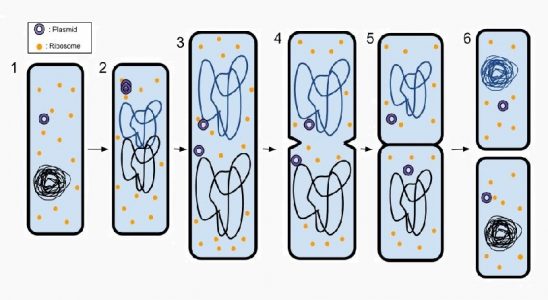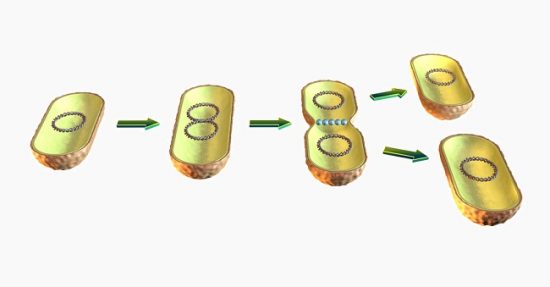Binary Fission Definition
Binary fission is the process through which asexual reproduction happens in bacteria. During binary fission, a single organism becomes two independent organisms. Binary fission also describes the duplication of organelles in eukaryotes. Mitochondria and other organelles must reproduce via binary fission before mitosis so each cell has ample organelles.
Binary Fission Overview
Binary fission is a relatively simple process, compared to mitosis, because binary fission does not involve reproducing organelles or complex chromosomes. The process starts with the replication of the DNA within the cell. Mitochondria must also replicate their DNA before binary fission, though other organelles have no DNA.
Then, the DNA is separated into alternate ends of the single cell. The plasma membrane pinches the cell apart, and one cell becomes two. With a fully-functioning DNA molecule, each cell is then capable of all the functions of life. Therefore, the cells become independent organisms.
Organelles, though they are not independent organisms, separate in this way as well. Endosymbiotic theory says that mitochondria and chloroplasts were once independent organisms that have evolved to live within other cells. As such, they still replicate via binary fission.
Binary Fission Steps

Before binary fission of a prokaryote, as seen in step 1 of the above graphic, a prokaryote’s DNA is tightly wound. Sometimes, the prokaryote will carry small plasmids, which are small rings of DNA that carry extra genetic information. During the second step of binary fission, the DNA is unraveled. As it is unraveled, specialized proteins gain access to the DNA, which then works to replicate the ring of DNA. The same proteins work on the plasmids in the cell, duplicating them as well. By step 3, both the DNA and plasmids have been duplicated. The individual copies of DNA attach themselves to different parts of the cell membrane. As the cell elongates in preparation for division, the DNA molecules are pulled to different sides of the cell.
At step 4, a cleavage furrow appears in the cell membrane, as the cell wall and membrane start to pinch off and create two new cells. Finally, as seen in step 5, the cells become completely separated from one another as a new bacterial cell wall forms. The final step includes breaking any additional proteins or other molecules that still connect the two cells. Each cell now has everything it needs to continue the functions of life independently.
Binary Fission Examples
Binary Fission in Bacteria
All of the organisms in the domains Archaea and Bacteria reproduce asexually through binary fission. By far, bacteria account for the most populous organisms on the planet. The process of binary fission is a very stable one, and because bacteria have a very simple genome, there are relatively few mutations in prokaryotes as compared to eukaryotes. Eukaryotes must undergo many cell divisions before gametes can be produced for sexual reproduction, therefore many more mutations can be introduced before offspring are created.

Bacteria will go through the steps listed above as they proceed through binary fission. However, there are many variations of this scheme that have evolved in the different lines of bacteria. For instance, the bacteria Bacillus subtilis is a bacteria that exists in the soil and in the gut of some mammals, including humans. This bacteria can divide equally, creating two relatively identical cells, or it can create a much smaller division, which acts as a spore.
This endospore is much more resilient than its larger counterpart and can travel through an animal or the environment to new locations or simply survive until favorable conditions return. Bacteria also exhibit variations in the ways in which they elongate to divide. Some bacteria extend at the far end, while others grow from the middle outward. Even the timing with which the bacteria divide differs and is directed by genetics. Some bacteria can divide in as little as 20 minutes, while others take many hours.
Binary Fission in Organelles
Although the process of mitosis in eukaryotes is similar to binary fission, it is much more complex because eukaryotes have larger genomes and many organelles to duplicate. However, the organelles of eukaryotes replicate using binary fission. Many organelles even harbor their own DNA, which directs their functions and growth. Mitochondria, for example, the energy center of the cell, must make many copies of itself to provide a dividing cell with enough energy. Mitochondrial DNA is replicated, and the organelle divides in the same sequence described above.
Throughout the cell, each organelle must be replicated at least once, if the resulting cells are to have the proper amount of organelles. As the organelles undergo binary fission, they are also moved by the directions of the spindle apparatus and microtubules to opposite ends of the cells. Thus, when the cell divides through cytokinesis after mitosis, each cell is ready to operate independently immediately.
Quiz
